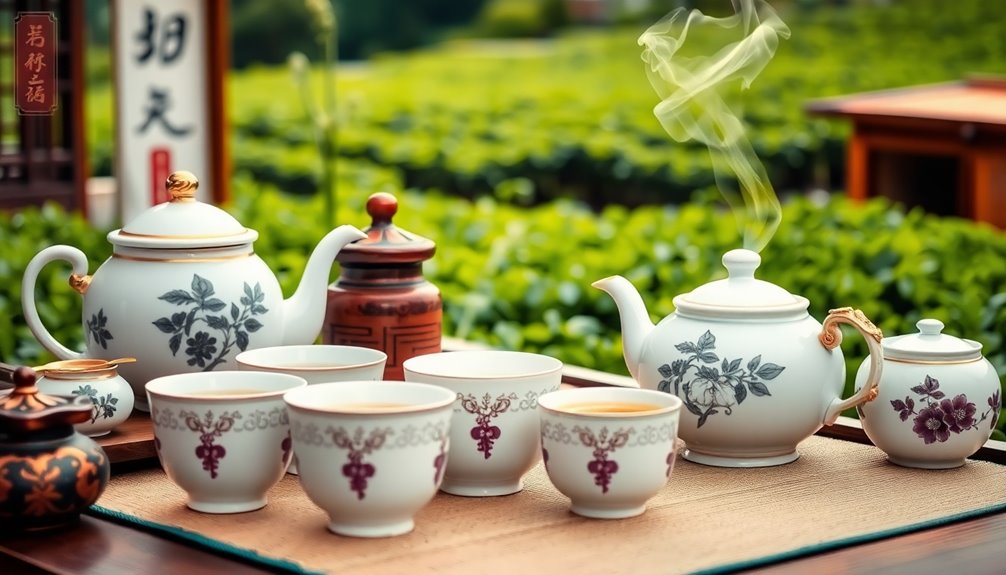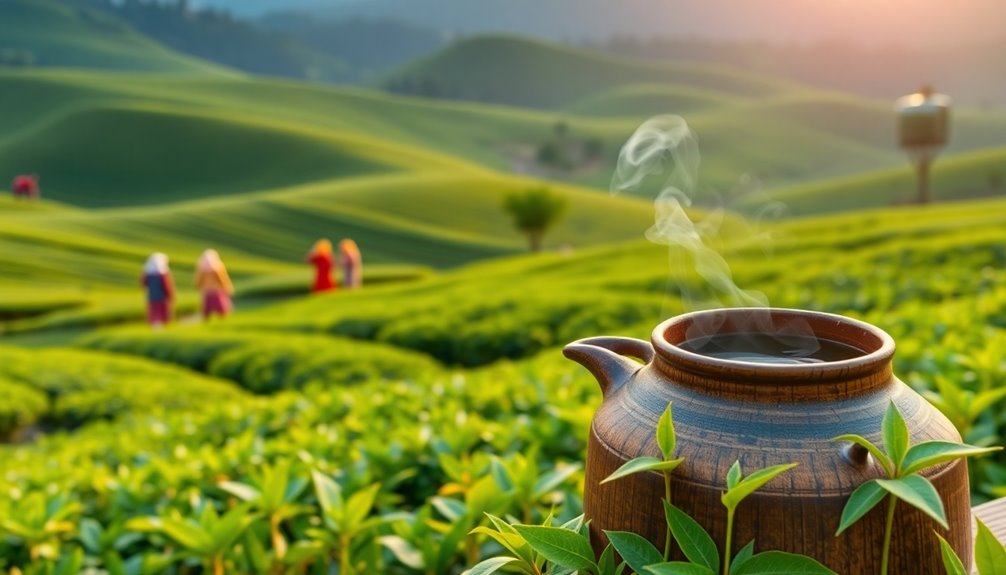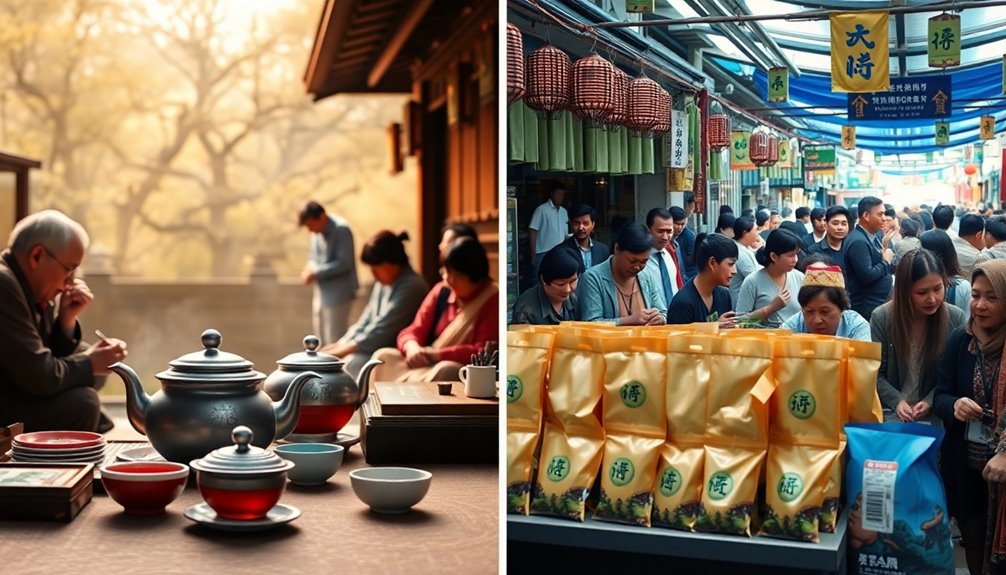If you're wondering which country truly invented tea, the answer lies in China. According to legend, Emperor Shen Nung discovered tea around 2737 BC, making it the earliest documented origin of this cherished drink. During the Tang dynasty, tea's significance grew as cultivation and processing techniques advanced. However, the introduction of tea to Japan and its commercialization in Europe opened a complex discussion about cultural ownership. Today, tea's influence on trade and diplomacy further complicates its history. To fully understand this rich tapestry, you might want to explore how tea's journey shaped cultures worldwide.
Key Takeaways
- Tea is attributed to China, with legends of Emperor Shen Nung's discovery dating back to around 2737 BC.
- The earliest written records of tea date from the Han dynasty, showcasing its ancient roots in Chinese culture.
- Cultural adaptations occurred globally, leading to diverse preparation methods, but China's influence remains dominant in tea's history.
- The introduction of tea to Japan by Buddhist monks exemplifies cultural exchange rather than appropriation, highlighting tea's international significance.
- European commercialization in the 16th century raises debates about cultural ownership, complicating the narrative of tea's invention and appreciation.
Introduction

Tea, a beverage cherished worldwide, has a rich and complex history that sparks ongoing debate about its true origins. You might be surprised to learn that the origins of tea are attributed to China, where legend says Emperor Shen Nung discovered it around 2737 BC while boiling water.
The earliest written records of tea consumption date back to the Han dynasty, with evidence of tea leaves found in a mausoleum from the 2nd century BC. As you delve deeper, you'll notice how tea culture evolved significantly during the Tang dynasty (618-906 AD), establishing tea as a vital cultural beverage.
While Chinese merchants and monks were pivotal in spreading this beloved drink, the introduction of tea to Europe came later, in the late 16th century, through Portuguese traders. This moment marked a significant shift in tea's journey, igniting a debate about its invention.
Various cultural adaptations emerged as tea spread across the globe, leading to distinct preparations and consumption methods in different regions. This ongoing discussion about tea's origins invites you to explore the intricate tapestry of history, culture, and tradition that surrounds this cherished beverage.
Tea's Ancient Cultivation Practices

Among the earliest known agricultural practices, the cultivation of *Camellia sinensis* in ancient China laid the groundwork for the global tea industry we know today. Around 2700 BCE, the earliest tea plants were nurtured primarily for their medicinal use. Over time, this practice evolved, turning tea into a daily beverage cherished across cultures.
During the Tang dynasty (618-906 CE), tea cultivation flourished as refining processing techniques enhanced the quality and variety of teas. This period marked a significant leap in how tea was prepared and enjoyed, shaping preferences that endure to this day.
As the demand for tea grew, trade routes like the Silk Road played a crucial role in spreading Chinese tea cultivation beyond its borders, introducing these practices to Southeast Asia and eventually India.
In particular, Assam emerged as a notable tea-producing region, thanks to British encouragement in the 19th century. The ancient cultivation methods from China, combined with regional adaptations, led to a rich tapestry of tea culture.
Today, the legacy of these practices continues to influence how tea is cultivated and appreciated around the world.
Tea's Role in Trade
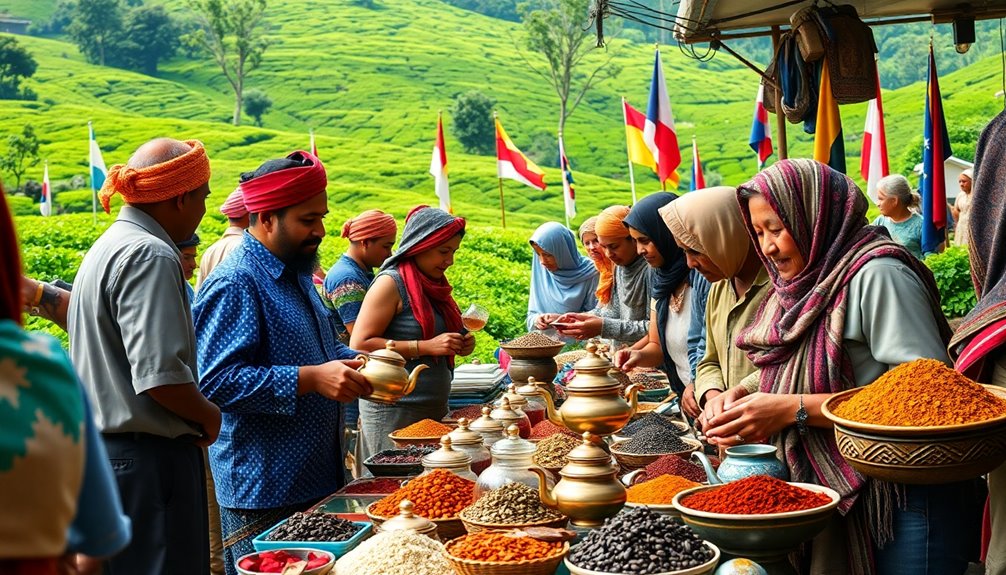
As tea cultivation spread beyond China, it quickly became a significant commodity in international trade. The Dutch pioneered the commercial import of tea from China in 1606, setting the stage for a burgeoning tea trade across Western Europe.
The East India Company then dominated this market, controlling tea imports to Britain until 1834, when individual merchants gained the freedom to engage in the tea trade. This shift led to a massive increase in tea consumption and availability in British society.
In the 19th century, the British government slashed tea taxes from 119% to just 12.5%, making legal tea far more affordable. As a result, smuggling practices that had once thrived dwindled significantly.
During both World Wars, the government took charge of tea importation to ensure consistent supply, highlighting tea's vital role in everyday life.
The opening of the Suez Canal in 1869 revolutionized global tea distribution, favoring steamships over traditional clippers. This change altered trade routes and made importing tea more efficient.
In essence, tea's journey from a Chinese delicacy to a staple of international trade reflects its profound impact on economies and societies worldwide.
Tea's Influence on Global Diplomacy
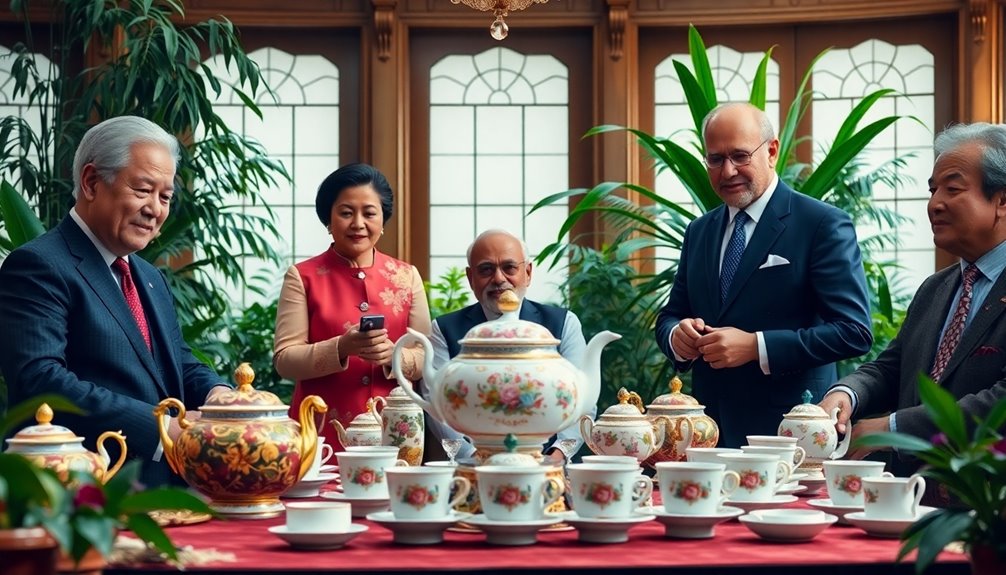
Throughout history, the introduction of tea to Europe has sparked significant trade relationships that influenced diplomatic ties between nations. The British East India Company's monopoly on tea trade shaped colonial policies, leading to rising tensions with American colonies. The Boston Tea Party in 1773 became a pivotal event of the American Revolution, symbolizing resistance against British control.
Tea didn't just fuel conflict; it also served as a diplomatic gift. For instance, when the Mongolian Khan gifted tea to Tsar Michael I of Russia in the 1630s, it enhanced relations between the two nations.
By the 18th century, Britain's soaring tea consumption prompted negotiations and treaties with China, solidifying Britain's role in global trade and diplomacy.
Moreover, tea evolved into a cultural beverage, transforming coffee houses into informal venues for diplomatic discussions. Here, politicians and business leaders mingled, shaping public opinion and international relations.
Thus, tea transcended its status as merely a drink; it became a catalyst for both conflict and collaboration, illustrating how a simple beverage could wield such profound influence in global diplomacy.
Cultural Appropriation Debates
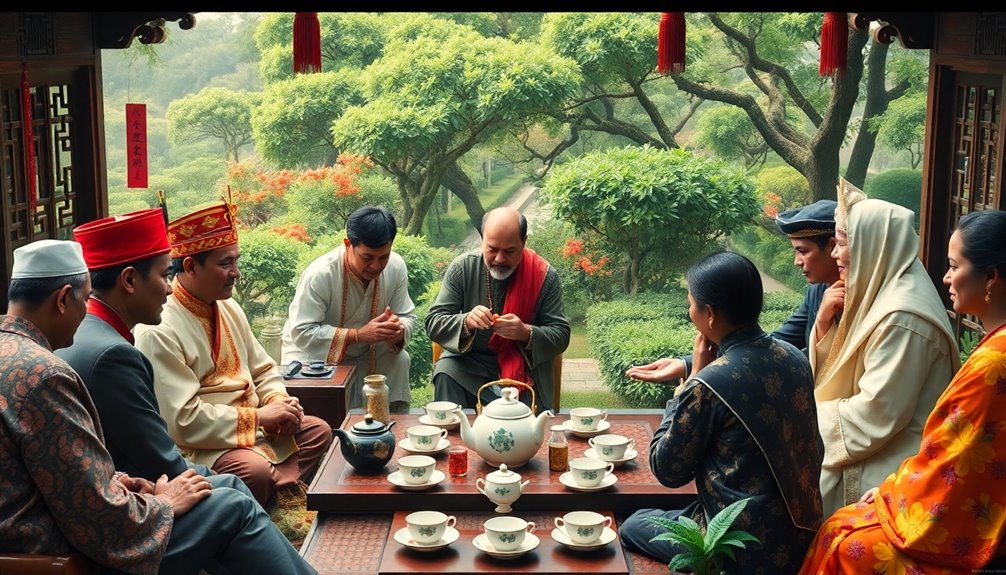
The impact of tea on global diplomacy raises important questions about cultural appropriation and ownership. China's central role in tea's history, often credited to Emperor Shennong's discovery around 2737 BC, highlights the complexities surrounding this debate.
When tea was introduced to Japan by Buddhist monks in the 8th century, it represented a respectful cultural exchange rather than appropriation. However, as European countries like the Dutch and Portuguese began importing tea in the 16th century, commercialization blurred the lines of ownership.
The British further popularized tea in the 17th century, particularly after Catherine of Braganza married Charles II, embedding the beverage into their tea drinking culture. This integration raises questions about whether this was a cultural appropriation or a genuine exchange.
Today, discussions often focus on how new trends, such as bubble tea, can detach the drink from its cultural roots. While these innovations can celebrate tea's legacy, they also risk commodifying and rebranding traditional practices.
As you consider these dynamics, it's essential to reflect on how globalization influences cultural narratives and the potential consequences of appropriation versus appreciation.
Practical Applications

Tea offers numerous practical applications that extend far beyond its role as a beloved beverage. Originating in China around 2700 BCE, the tea plant has a rich history of tea consumption. Drinking tea not only provides enjoyment but also offers health benefits, especially with varieties like green tea, known for its antioxidants. Additionally, tea's antioxidant properties contribute to reducing oxidative stress, similar to the benefits found in coffee.
You might appreciate how tea has evolved over centuries, transitioning from its early consumption in China to becoming a staple in European countries. The introduction of tea to Japan by Buddhist monks in the 8th century demonstrates its role in cultural exchange, enriching global traditions.
Today, the tea industry thrives, fueled by the popularization of tea across the world. With its cultivation spreading to regions like India and Sri Lanka during British colonialism, tea has become a global commodity, transforming local economies and practices.
As you explore the world of tea, consider its multifaceted applications—from social rituals to health benefits—and how its historical roots in China continue to influence modern consumption. Engaging with tea allows you to connect with centuries of tradition and enjoy its enriching qualities.
Conclusion
In the end, the question of which country truly invented tea is more complex than it seems. While China often takes the spotlight for its ancient practices, other nations have made significant contributions to tea's evolution and global spread. This ongoing debate highlights not just cultural pride but also the interconnectedness of our histories. So, whether you enjoy a soothing cup of Chinese green tea or a robust English breakfast, remember that tea's journey is a shared one.

